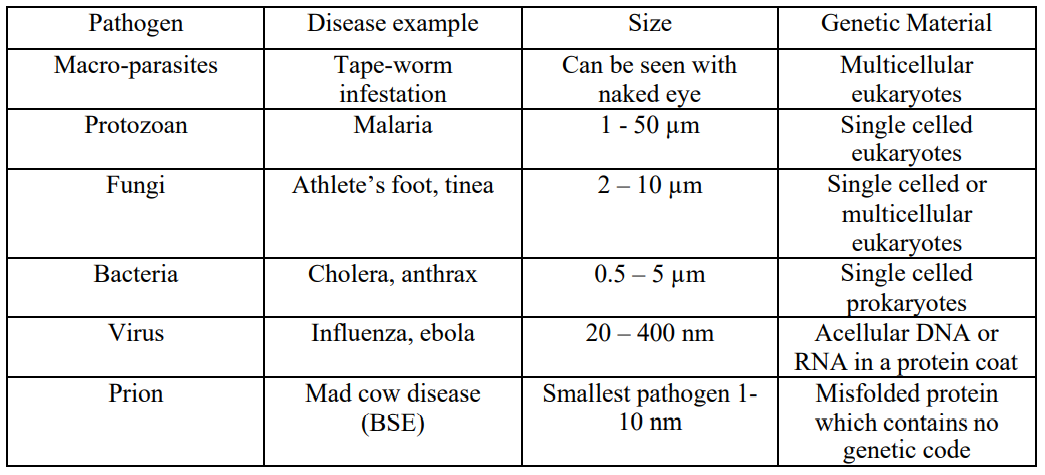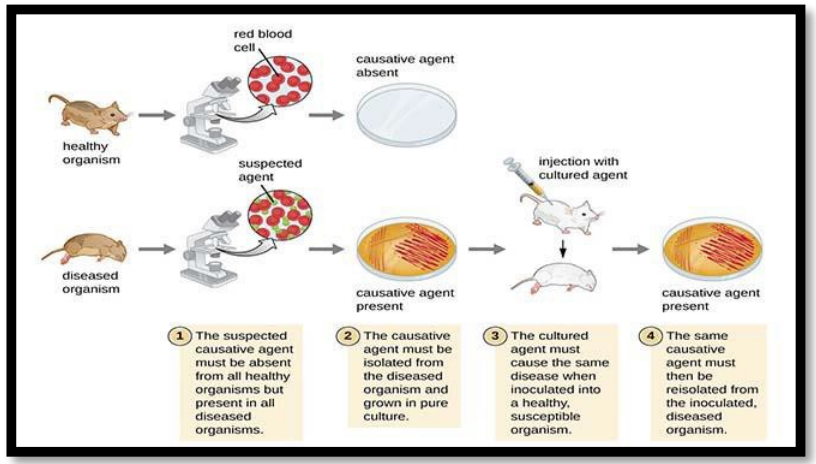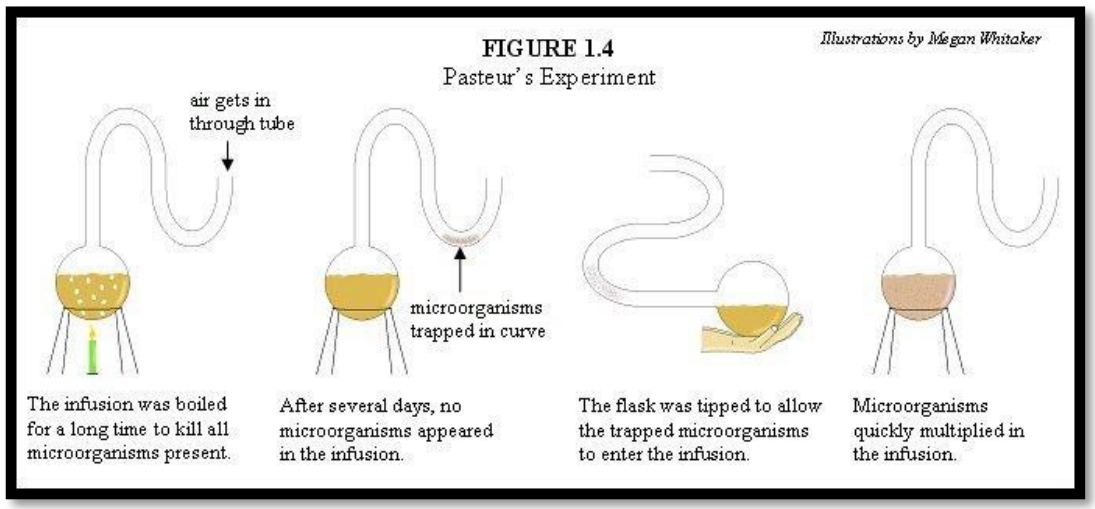On your way to Biology mastery? Enrol in our 99.5 studyscore masterclass. Click here!
Inquiry Question 1: How are diseases transmitted?
Content Descriptor: Describe a variety of infectious diseases caused by pathogens, including microorganisms and macroorganisms and non-cellular pathogens, and collect primary and secondary sourced data and information relating to disease transmission, including:
Classifying different pathogens that cause disease in plants and animals (7.1.1)
Classification table:

Investigating the transmission of a disease during an epidemic: (7.1.2)
Ebola:
Ebola is transmitted through bodily fluids or through close bodily contact. Ebola’s suspected natural reservoir is in bats and is transmitted to humans through uncooked bat meat. Significant factors which have impacted the spread of Ebola in Africa include:
- Traditionof manual handling of remains of the deceased
- Traditionof burning the body of the deceased
- Poorgeneral sanitation, e handwashing
Design and conduct a practical investigation relation to the microbial testing of water or food samples: (7.1.3)
Investigation to test for microbes in food:
- Preparetwo agar plates with nutrient
- Contaminatea Q-tip with the tested food source
- Inoculatethe first plate with the contaminated Q-tip, ensuring it is only briefly exposed to air
- Brieflyexpose the second agar plate to air
- Incubateboth agar plates for three days
- Compare the number of colonies and approximate area of the contaminated plate with the control
Investigate modes of transmission of infectious diseases, including direct contact, indirect contact and vector transmission: (7.1.4)
Direct contact:
- Spreaddirectly from one person to another. This can be by close contact, or bodily
- HIV is an example of a disease spread through direct contact (intercourse).Indirect contact:
- Spread not through direct contact, for example through air, ground, soil or contaminated
- Cholera is an example of a disease spread through indirect contact. Measles can be spreadthrough direct or indirect
Insect vector:
- Transmissionfrom one person to another via an infected
- Mosquitoesare the insect vector for the protozoan disease
Communicability of a disease depends on how easily it leaves a host and enters another person. The most communicable diseases are easily passed from one person to another.
Content Descriptor: Investigate the work of Robert Koch and Louis Pasteur, to explain the causes and transmission of infectious disease, including:
Koch’s postulates: (7.1.5)
Contributions of Koch:
German physician who took his medical degree in 1866. Upon moving to a county where the livestock were greatly affected by anthrax, and learning of Pasteur’s evidence for germ theory, Koch discovered the cause of anthrax to be Bacillus anthracis.
In 1877 Koch described new techniques of fixing and staining bacteria. He used dye to stain the bacteria and solid gels to isolate them rather than sticky liquids.
In 1884 he made the list of criteria to prove that an organism causes a set disease; Koch’s postulates. In 1891 he found the agents that cause diphtheria, typhoid, tetanus and tuberculosis. In 1905 he developed the tuberculin test for tuberculosis.
Koch’s postulates:
Koch’s postulates are a method of linking a set disease to a set disease causing pathogen:
- Organismmust be present in every diseased individual
- Theorganism must be able to be isolated and grown in pure culture
- Purecultures must induce disease when given to another organism
- The same microbe must be able to be isolated, cultured and identified as the original species

Pasteur’s experiments on microbial contamination (7.1.6)
Contributions of Pasteur:
Pasteur was originally a chemistry teacher, until one of his student parents asked him to help with problems with spoiling wine in 1856. Pasteur proved that yeast was the cause of normal fermentation, rather than “unstable vibrations” and that the cause of the souring of wine was contamination by micro-organisms.
Further studies showed organisms caused fermentation of wine, beer and vinegar. He suggested heating the liquids to moderate temperatures to kill the microbes and then adding the desired organisms. In the 1860’s he conducted his experiment on the swan neck flasks, disproving spontaneous generation and with his work on anthrax, he developed the germ theory.
After isolating and diluting infected sheep’s blood, he found that anthrax was just as active as the original. He produced a vaccine for anthrax in 1882 which was publicly tested, educating the public about vaccination.
Pasteur’s experiment:
Method:
- Fill twolong neck flasks with nutrient broth.
- Heat and bend oneof the flask necks into a swan neck
- Boilboth broths to kill any microbes
- Leavefor a number of days
- Examinethe colour of each broth

Other modifications to his experiment included snapping the neck off the bent flask once finished or pouring the condensation which trapped dirt back into the flask.
Both broths were composed the same, and both were boiled so no microbes were present. The broth that was exposed to the environment spoiled, while the broth which was not exposed did not.
However, the swan neck flask still allowed air to diffuse through the layer of water in the neck while trapping microbes. Since the flask still had access to air, the germs did not simply appear, they had to come from somewhere in the environment.
Content Descriptor: Assess the causes and effects of diseases on agricultural production, including but not limited to:
Plant diseases: (7.1.7)
Citrus canker:
- Causedby bacterium Xanthomonas citri
- Formslesions on stems, leaves and fruit
- Notifiabledisease – if found must be reported to authorities
- Outbreakin 2005 had high economic impact
- Australiawas declared free of citrus canker in 2009
Wheat rusts:
- Causedby several species of fungi
- Causedamage to various parts of plants
- Spreadby spores
- Controlledvia fungicides and resistant strains
Potato moth:
- Destructivepest of potatoes
- Caterpillarfeeds on the leaves and tubers
- Insecticideskill caterpillars
Karnal bunt of wheat:
- Notifiablefungal disease
- Attacksflowers and invades what kernels
- Highlyinvasive and threat to wheat industry
- Molecularprobes can detect spores
- Significantcost of identification and restriction
Animal diseases: (7.1.8)
Internal parasites:
- Roundworms and flatworms affect agricultural animals reducing productivity and causinghigher mortalities
Anthrax:
- Bacterialinfection caused by Bacillus anthracis
- Affectsmany species of livestock and humans
- Notifiabledisease – if found must be reported to authorities
- Cansurvive in alkaline soil, infecting animals once they are exposed
- Bloodtests can identify
- Antibioticsuseful in early stages
- Relatedcosts include:
- Disposalof infected carcasses
- Animaldeath
- Treatment
- Vaccination
- Consumerrejection
ABLV:
- AustralianBat lyssavirus
- Relatedto rabies, transferred through bites
- Causesseizers and inflammation
- Presentin all bat populations
- Affectedno agriculture
Flystrike:
- Causedby species of blowflies
- AffectAustralian sheep
- Layeggs in sheep, maggots eating tissue causes wounds and attracting more flies
- Preventionincludes:
- Removingtails
- Shearingand chemical treatments
- Higheconomic impact and decreased productivity
Content Descriptor: Compare the adaptations of different pathogens that facilitate entry into and transmission between hosts: (7.1.9)
Complex life cycles:
- Manypathogens live in multiple hosts
- Thehost of sexual reproduction is called the primary host
- Thehost of asexual reproduction is the secondary or intermediate host
- Complexlife cycles take advantage of an aspect of the host:
- Malariais carried by the insect vector Anpheles mosquito
- Yersinia pestis which causes bubonic plague blocks the digestive tracts of fleas, forcingthem to vomit to remove the blockage
Attachment structures:
- Bacteriahave adhesion proteins to help them bind to surfaces
- Adhesionstructures include fimbriae (short) and pili (long)
Active transport:
- Virusesbind to receptors triggering endocytosis into cells
Resistant structures:
- Structureswhich help them live outside the host
- Endospores are tough and extremely resistant spores which survive outside of hosts. Anexample of this is anthrax
- Virusoutside of host is called virion, some viruses cannot survive for long, such as HIV
- Viral envelopes help the virus avoid the host immune system, however it often means they arenot very virulent outside of the body
Inquiry Question Review: How are diseases transmitted? (7.1.10)
You should be able to:
- Describea variety of diseases and how they spread
- Understandthe process to test for microbial contamination through experimental methods
- Describeand assess the scientific importance of the work of Koch and Pasteur
